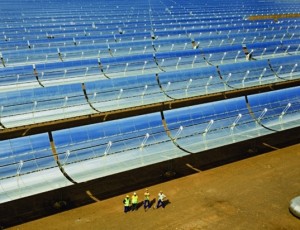In Northern New England, where I live, the sun exists only in rumor and faint memory for weeks at a time. So when sustainable energy advocates talk solar, I think of my late-February pallor and mentally check out of the discussion. Long nights, short days of limited sun. Wind for my region maybe, but solar?
 Well, yes, actually. Two news items that filtered through the excellent Inhabitat blog recently give hope to anyone who thinks the sun could help wean us off fossil fuels. The first comes from Sicily, where the energy company Enel recently fired up “Archimede” the world’s first utility-scale molten salt power plant. Archimede uses mirror concentrators to super-heat a molten salt solution circulating through a pipe array. The heat pipes power boilers that create steam to drive electrical turbines. The key to this system is that it can store energy for nights and cloudy days, much like the solar thermal systems I blogged about a while back. The combination of sodium nitrates and potassium salts in the system can accumulate heat for extended periods. That ability to ride out nights and cloudy days makes thermal solar more practical for sun-deprived areas like mine. Photovoltaic solar, the more widely known solar technology, generates electricity directly from the sun’s rays instead of through turbines. It’s most often associated with places like the American Southwest, which have weeks on end of uninterrupted sunshine.
Well, yes, actually. Two news items that filtered through the excellent Inhabitat blog recently give hope to anyone who thinks the sun could help wean us off fossil fuels. The first comes from Sicily, where the energy company Enel recently fired up “Archimede” the world’s first utility-scale molten salt power plant. Archimede uses mirror concentrators to super-heat a molten salt solution circulating through a pipe array. The heat pipes power boilers that create steam to drive electrical turbines. The key to this system is that it can store energy for nights and cloudy days, much like the solar thermal systems I blogged about a while back. The combination of sodium nitrates and potassium salts in the system can accumulate heat for extended periods. That ability to ride out nights and cloudy days makes thermal solar more practical for sun-deprived areas like mine. Photovoltaic solar, the more widely known solar technology, generates electricity directly from the sun’s rays instead of through turbines. It’s most often associated with places like the American Southwest, which have weeks on end of uninterrupted sunshine.
But photovoltaic’s geographical limitations were never a technology problem, they were an economic problem. Solar panels work as well on a sunny New England day as they do on a sunny day anywhere else. They just didn’t work often enough to make them economically feasible because solar panels are expensive. Maybe not for much longer, though. Researchers at Duke University just released a study that says solar energy is now cheaper than nuclear energy, partly because the cost of panels is dropping. When it drops enough, it will be economically feasible to mount solar panels on rooftops to power air conditioners during hot summer days, or heat during clear, sunny winter days to reduce oil and coal consumption.
Now if I could just do something about that late February pallor …